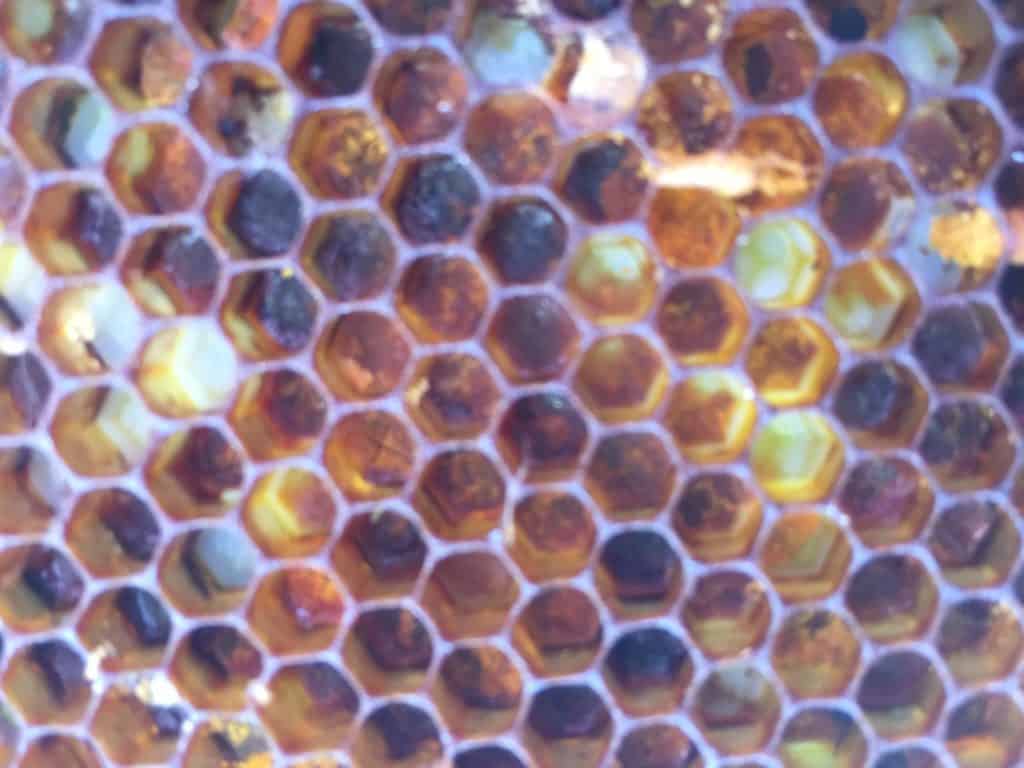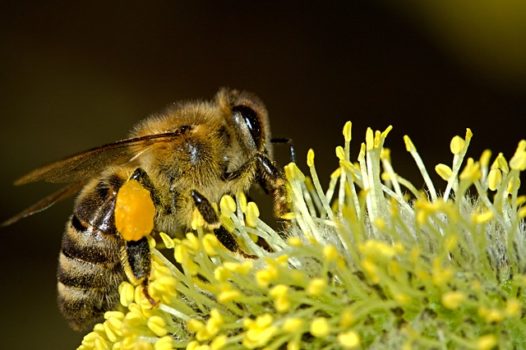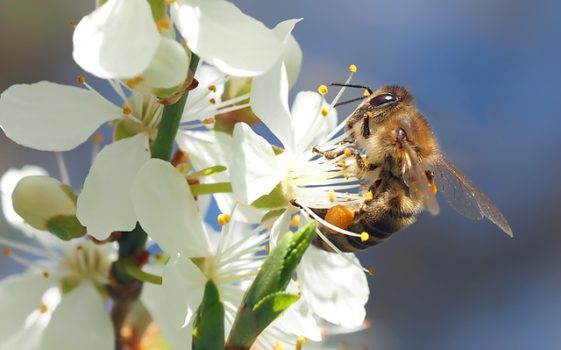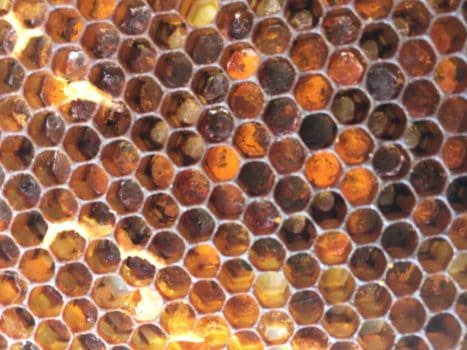Someone asked me specifically, “Do bees eat pollen or bee bread?” My initial reaction was to just say yes. I assumed that pollen and bee bread are the same thing. I was not correct; pollen and bee bread are not the same thing. Bee bread is actually chemically altered and fermented pollen.
The quick answer to the question if bees eat pollen or bee bread is that bees will eat both pollen and bee bread. Pollen contains essential protein for the bees. Bees do digest and utilize fresh pollen especially when establishing a new colony. Such as when a beekeeper installs a bee package to a new beehive.
Bee bread is pollen that has been processed by the bees, and has a lot more nutritive properties available to the bees than straight pollen. A great series of articles about bee bread is here. They describe some of the nutrition and scientific studies about bee bread.
What do honey bees eat?
Food for the bees consists of a carbohydrate which is nectar gathered from flowers and blossoms that is transformed into honey. This is a fascinating process that I will address in another article.

Bees cannot live off of carbohydrates alone. Bees need protein and other nutrients as well. Pollen is the source of the protein. As the bees are gathering nectar, they also gather pollen. The pollen grains stick to hairs all over their bodies. They collect the pollen sticking to their hairs and push it to their back legs and pack it on their hind legs to long hairs there. Their back legs act as a kind of pollen basket. They have a resemblance to saddle bags of pollen on their legs. During this process the pollen is moistened with nectar as the bees push the pollen back. It’s interesting to see the different colors of pollen stuck to their legs as they fly back into the hive.
When the honey bee goes back to the hive they deposit the pollen into cells of the comb. Mid aged worker bees will pack the pollen with their heads and add nectar with digestive fluids. The pollen is packed down layer upon layer until the cell is about three quarters full or so. The packed layered pollen is then topped off with a small amount of honey. Finally, the cell will be topped off with a cap of wax.

Pollen grains harvested directly from the flower will have some strong exterior cellulose creating a tough barrier for the bee to break down. The nectar, digestive fluid, and packed pollen reacts and breaks down the tough cellulose exterior. With the tough cellulose broken down, and a partial digestion and fermentation some good protein, amino acids, and vital nutrients become available and is called bee bread.
The process of storing and fermenting food reminds me of a silo on a farm. A silo is used to store feed and while it is stored it becomes fermented which gives the livestock feed different properties than just straight feed. On the dairy farm where I worked at, we would silo field corn as well as alfalfa. We would use upright silos as well as silage pits. The protein content remained high as well as a lot of the nutrients. The cows loved the fermented feed and it was a vital part of the dairy feed regimen.
Through the fermentation and partial digestion of the pollen the proteins become higher quality and more vitamins become available. We humans use fermentation quite a bit for storage of our food. Some examples that come to mind are sour kraut, kimchi, and pickles. Some to the enzymes found in bee bread are the same enzymes found in yogurt and kefir.
Some of the nutrients that become available with the transformation of pollen into bee bread are:
- Vitamin K
- Enzyme levels are increased
- Antioxidants
- Zink
- Magnesium
- Silica
Often the bee bread will be different colors from cell to cell. The bee bread will also be different colors through the layers of the cell itself. These different colors are from the different colors of flowers and blossoms that the bees harvest pollen from.
In one frame of bee bread I have seen white, orange, red, blue, yellow, and purple cells. I love to see all the colors. With all the varied color there will be a good array of different nutrients from the different pollens. As the bee bread process goes on the colors will begin to blend as the outer layer of the pollen breaks down. The brighter the color the newer the pollen.
Bee Bread as a health supplement for humans
Some people harvest bee bread along with honey for humans to consume. Bee bread is known also by the name perga or ambrosia. You may find these different names but they are all referring to the fermented, processed pollen that bees have gathered.
The claims of health benefits from bee bread are interesting and may have some merit. There hasn’t been a lot of research done in the area of the nutritional and medicinal benefits of bee bread, but there have been a few. Many homeopaths have found bee bread helpful and use it in their work. Caution and research should be used whenever ingesting something that is purported to be a treatment or cure of an illness or health condition.
Bee bread health benefits for Honey Bees.
In beekeeping the practice of using antibiotics was used for years. The beginning beekeeping class I took recommended that I mix terramyacin with powdered sugar and dust the hive with the mixture.
The treatment using antibiotics was recommended in the spring as the temperature began to rise, and in the fall after the fall honey harvest. I had healthy bees and they seemed to do well. However, there is an idea now that perhaps this practice may have killed beneficial bacteria as well as created stronger strains of harmful bacteria.
The creation of bee bread also creates beneficial bacteria for the bees. I haven’t treated my hives with antibiotics for a few years now. Mostly because I can’t buy it off the shelf anymore, but it seems that the use of antibiotics possibly did more harm than good.
An interesting series of scientific observations and conclusions can be found here. I really appreciate Randy Oliver’s approach. He is one who prefers rigid science and facts. The proposed ideas and the scientific conclusions that are found with his research and collaboration with scientists are interesting and based in controlled experimentation.
The conclusions drawn are informative and can make you question and change your beekeeping practices. Microbes, yeasts, fungus, and probiotics found in bee bread are just beginning to be identified and understood. It does prove that bee bread isn’t just a simple storage of pollen. Bee bread is a complex source of nutrients beyond just protein.

Summary
So, yes bees do eat pollen and bee bread. When a hive is being established the colony needs to survive and use the fresh pollen as a protein source. Bee bread is the processed pollen and has a lot more nutrient available for the use of the bees.

